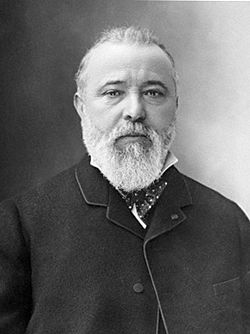Zénobe Gramme facts for kids
Quick facts for kids
Zénobe Gramme
|
|
|---|---|

Zénobe Gramme by Nadar, 1893
|
|
| Born | 4 April 1826 Jehay-Bodegnée, Belgium
|
| Died | 20 January 1901 (aged 74) Bois-Colombes, France
|
| Resting place | Père Lachaise Cemetery |
| Occupation | electrical engineer |
| Known for | Gramme dynamo |
Zénobe Théophile Gramme (born April 4, 1826 – died January 20, 1901) was a clever Belgian engineer. He is famous for inventing the Gramme machine. This machine was a special kind of direct current (DC) dynamo. It could make electricity much more smoothly and with higher power than older machines.
Contents
Gramme's Journey to Invention
Gramme did not have much formal schooling. He was very good with his hands. When he left school, he became a joiner, which is someone who builds things with wood.
Later, he moved to Paris, France. There, he got a job making models for a company that built electrical equipment. This job sparked his interest in technology and electricity.
Building a Better Dynamo
Gramme worked hard and built a much better dynamo. He teamed up with Hippolyte Fontaine to start a business. Their company was called Société des Machines Magnéto-Électriques Gramme.
They made the Gramme dynamo, along with other parts like the Gramme ring and Gramme armature. In 1873, one of their Gramme dynamos was shown at a big exhibition in Vienna.
Awards and Recognition
Gramme's work was highly respected. In 1877, he was made an officer of the National Order of the Legion of Honour in France. This is a very important award.
In 1888, he received the last of the valuable Volta Prizes from the French government. This prize was given for important discoveries in electricity.
The Gramme Machine as a Motor
In 1873, Zénobe Gramme and Hippolyte Fontaine made an amazing accidental discovery. They found that their dynamo could also work in reverse! If you connected it to a power source, it would spin like a motor.
The Gramme machine became the first truly useful electrical motor. It was powerful enough to be used in factories and industries. Before Gramme's invention, electric motors were mostly weak and used as toys or for experiments in labs.
In 1875, a young inventor named Nikola Tesla saw a Gramme machine. He was studying at the Graz University of Technology. Seeing the Gramme machine gave him an idea about using it for alternating current. However, he couldn't develop this idea at that time.
Gramme's Personal Life
In 1857, Zénobe Gramme married Hortense Nysten. She was a widow and had a daughter named Héloïse. Sadly, Hortense passed away in 1890.
Later, on August 17, 1891, he married Antonie Schentur in Bois-Colombes.
Remembering Zénobe Gramme
Zénobe Gramme died in Bois-Colombes, France, on January 20, 1901. He was buried in the famous Père Lachaise Cemetery.
Tributes and Legacy
- In the town where his second wife grew up, Gramme helped build a special avenue. It was named Gramme-Allee in 1902.
- In the city of Liège, there is an engineering school named after him, called l'Institut Gramme.
- In 2005, he was voted 23rd in "Le plus grand Belge" (The Greatest Belgian). This was a TV show based on the BBC's "100 Greatest Britons."
- A training sailing ship of the Belgian Navy, A958 Zenobe Gramme, is also named after him.
Honours
- Commander in the Order of Leopold.
- Officer in the Legion of Honour.
Images for kids
See also





